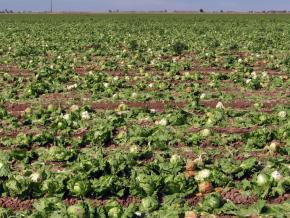A sickening system behind E. coli outbreaks
Like every other part of the free-market system, the priority in food production is agribusiness profits, not people’s health and safety, writes .
THE LATEST mass outbreak of food poisoning in the U.S. has once again highlighted the deadly consequences of a system in which food is a commodity for businesses to profit from, rather than a human right.
Caused by a strain of Escherichia coli (E. coli), the outbreak sickened at least 172 people in 32 states since March — 23 alone in the 10 days since May 9. Seventy-five of these people were ill enough to require hospitalization and at least one person died.
The bacterial strain that caused the outbreak “can release a toxin that damages the lining of the intestine, often leading to abdominal cramps, bloody diarrhea, vomiting and, in some cases, life-threatening kidney damage,” according to Consumer Reports. The risk is especially great for the very old, the very young and pregnant women.
Though the Centers for Disease Control (CDC) declared romaine lettuce — the source of the outbreak — safe to eat once again in mid-May, there will undoubtedly be another wave of foodborne illness, because an unsafe food supply is simply seen as a “normal” part of life in capitalist America.

Food poisoning can be caused by a variety of different bacteria and viruses. It is often caused by improperly handled food at a specific restaurant, facility or home. Such large-scale E. coli outbreaks, however, are generally caused by food which is contaminated at a farm or food processing facility.
In this case, the culprit appears to be contaminated lettuce grown around Yuma, California — but no specific source had been pinpointed as this article was written, leaving concerns that the risk of contamination had not been entirely eliminated.
SUCH OUTBREAKS have become so common that they attract relatively little media attention. The CDC has recorded 26 different multi-state outbreaks since 2006, more than one a year.
A more complete count would include almost 13,000 illnesses and 38 deaths in the U.S. since 1998 caused by food contaminated by E. coli. In March, Interstate Meat Distributors Inc. was forced to recall more than 14,000 pounds of ground beef after it tested positive for E. coli.
These outbreaks are an inevitable consequence of capitalist food production.
Under capitalism, food production is subject to the same drives as any other for-profit industry — maximize profit or be overtaken by competition and go out of business. Cutting costs and maximizing production are viewed as primary, and producing safe and wholesome food is a hostage to that drive, done only to the extent that businesses are forced to do so.
Modern meat-production facilities are inhumane factories where huge numbers of animals are processed in unsafe conditions by poorly paid workers enduring horrific health and safety risks. Ground beef produced under such conditions is a major culprit in E. coli outbreaks.
In one 2015 testing, Consumer Reports found bacteria that signified fecal contamination, including E. coli, in every single sample from 300 packages of ground beef that it tested.
In addition to E. coli, 20 percent of the samples contained C. perfringens, “a bacteria that causes almost 1 million cases of food poisoning annually,” Consumer Reports wrote. “Ten percent of the samples had a strain of S. aureus bacteria that can produce a toxin that can make you sick. That toxin can’t be destroyed — even with proper cooking.”
IN ADDITION to the contamination of meat, one of the industry’s main waste products is animal manure, which is often stored in vast man-made, open-air “lagoons” frequently located in working-class and poor communities.
In addition to a noxious stench that affects these communities, rainfall can cause these lakes to run over, making rivers of feces spillover and contaminate nearby farms and waterways.
This is euphemistically referred to as “agricultural runoff.” The current E. coli outbreak was likely caused when a nearby industrial cattle or pig farm contaminated lettuce fields.
Although it is rarely reported, sickness from water contaminated in this manner is also very common. Illnesses from waterborne E. coli have occurred in virtually every state in the U.S. and killed 77 people in the last nine years alone. Despite the tremendous health toll on Americans, the toxic runoff — and often the conditions within meat-processing plants as well — are almost entirely unmonitored.
These recorded outbreaks are a small portion of the actual disease caused by food poisoning.
Food poisoning is often mistaken for a stomach flu. The illness then has to be identified and reported before a record is kept. The actual amount of sickness caused by food coated in animal waste is unknown, but much, much larger than the official records. According to Consumer Reports, for every known case of E. coli food poisoning, it’s estimated that another 26 cases occur.
In addition, the overuse of antibiotics on a mass scale in factory farming of animals has led to the rise of antibiotic-resistance bacteria, meaning that such foodborne illnesses are becoming not only more deadly, but harder to treat.
In a rational food production system, animals raised for meat wouldn’t be bred, housed or slaughtered in conditions that gave rise to such dirty and dangerous contamination, and animal waste would be utilized as valuable and safe fertilizer, rather than being a hazardous waste product which is disposed of as cheaply as possible.
Deadly outbreaks of E. coli infections are preventable, but not when profit for the rich is put before public safety.


